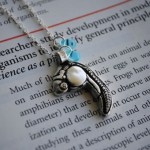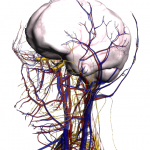Science
No. "If we could gather all the electric eels from all around the world," they would free their imprisoned brother from his Yuletide servitude and bio-tase the crap out of you, bro.
Just sayin'.
I have no idea how I missed this before the holidays (sorry!), but NBDesigns has a line of oxidized silver embryo jewelry that is pure vintage lab-chic. The embryonic mice are particularly adorable:
And, on the less-cute, more-sciency end of the spectrum, her embryonic chicks look just like illustrations in an old dev bio textbook:
I should also note, since we are coming up on Valentine's Day, that she makes Erlenmeyer flask earrings and pendants with little hearts. (You can also request a glass heart worked into the chain of the zebrafish embryo pendant, or check out her sloth & heart…
Most of what would ordinarily be blogging time this morning got used up writing a response to a question at the
Physics Stack Exchange. But having put all that effort in over there, I might as well put it to use here, too...
The question comes from a person who did a poster on terminology at the recently concluded American Geophysical Union meeting, offering the following definition of "data":
Values collected as part of a scientific investigation; may be qualified as 'science data'. This includes uncalibrated values (raw data), derived values (calibrated data), and other transformations of…
Via iO9, a Nature News slideshow of natural history engravings by physician Martin Lister's teenage daughters, who contributed technically accurate engravings of shells to one of his books, the Historiae Conchyliorum:
Historians now believe the pair were the first women to use microscopes to help produce some of their scientific drawings. Anna and Susanna's place in the history of science is explored in a biography of Martin Lister in preparation by historian Anna Marie Roos of the University of Oxford's Cultures of Knowledge project. In a recent web post, Roos describes how she stumbled…
My direct experience with prokaryotes is sadly limited — while our entire lives and environment are profoundly shaped by the activity of bacteria, we rarely actually see the little guys. The closest I've come was some years ago, when I was doing work on grasshopper embryos, and sterile technique was a pressing concern. The work was done under a hood that we regularly hosed down with 95% alcohol, we'd extract embryos from their eggs, and we'd keep them alive for hours to days in tissue culture medium — a rich soup of nutrients that was also a ripe environment for bacterial growth. I was…
It's the last week of the (calendar) year, which means it's a good time to recap the previous twelve months worth of scientific news. Typically, publications like Physics World will publish a list of top ten physics stories of 2010, but we're all Web 2.0 these days, so it seems more appropriate to put this to a poll:
What is the top physics story of 2010?survey software
I've used the Physics World list as a starting point, because you have to start somewhere. I added a few options to cover the possibility that they left something out, and, of course, you know where the comments are.
This…
When last we left this subject, I had pointed out that the phenomenon of embryonic similarity within a phylum was real, and that the creationists were in a state of dishonest denial, arguing with archaic interpretations while trying to pretend the observations were false. I also explained that constraints on morphology during development were complex, and that it was going to take something like a thorough comparative analysis of large sets of gene expression data in order to drill down into the mechanisms behind the phylotypic stage.
Guess what? The comparative analysis of large sets of…
Our final science-themed Christmas ornament is this Santa and friend:
What does walking a dog have to do with science? If you have to ask that, you're reading the wrong blog. Dog-walking is essential to science-- that's where we get some of our best ideas!
In a broader sense, this one can be said to represent the importance of maintaining some balance between science and the rest of your life. No matter how important the problem you are working on may be, your dog still needs walking, your kids need to be read to, and your family needs you to spend time with them. Especially at the holidays…
Next up in our series of science-themed Christmas ornaments are these two dinosaurs:
Why? Because dinosaurs are awesome. Seriously, do you really need to ask?
My readers might not think that a Plexiglass box full of blinking colored lights cum most advanced computer in the galaxy would go to the trouble of celebrating Christmas, much less putting up an actual Christmas tree. Well, actually, he didn't. His wife did. But, then, Orac is a Plexiglass box of blinking colored lights. Be that as it may, there are a couple of cool decorations that I can't resist showing off. First, courtesy of the James Randi Educational Foundation, we have the infamous Season of Reason ornament:
By the way, if you're looking for a good secular organization dedicated to…
Next up in our series of science-themed Christmas ornaments is this squirrel:
A reminder that you can't trust those furry little bastards...
What do squirrels have to do with science? As Emmy (and any other dog) will tell you, squirrels are representatives of all that is evil and twisted. And, unfortunately, science is just as plagued by evil hucksters as any other human endeavor. There are evil squirrels all over the place, telling you that quantum measurement lets you think your way to immortality, or nonsensical phony quantum states are the key to infinite free energy, or any of a…
Continuing our series of science-themed Christmas tree ornaments, we have this cute pair of reading bears:
"But wait," you say, "reading isn't a science!" Ah, but while reading itself may not be a science, science is nothing without the scientific literature. The really essential step in the process of science is the communication of scientific results to others. That's what allows future scientists to "stand on the shoulders of giants," to borrow a phrase from Newton, using past results as the basis for future experiments. Reading the results of others is absolutely essential to science.…
We didn't do a Christmas tree last year, because we figured SteelyKid wasn't yet old enough to be safe around it. We put one up this year, though, and she's been very grown-up and careful around it, so all is well.
The return of the Chateau Steelypips Christmas tree means I can also revive a sort-of tradition here, namely the posting of pictures of ornaments with explanations of how they're really about SCIENCE! (say that last word a la thomas Dolby for the full effect). We'll start with an easy one:
This is a shiny green ball with a big ring around it. As this clearly isn't one of the…
During the six years of its existence, one frequent complaint I've had on this blog, it's been about how the press covers various health issues. In particular, it's depressing to see how often dubious and even outright false health claims, such as the claim that vaccines cause autism, that cell phones or powerlines cause cancer, or that various questionable or even quack remedies work for various diseases are reported credulously. Often this takes the form of a journalistic convention that is more appropriate for politics and other issues but not so appropriate for scientific and medical…
Somebody is angling for an Ig-Nobel, I think. Apparently, it's a Danish myth that you can absorb alcohol through your feet, so soaking your feet in a tub of spirits is a way to get drunk (they also mention that soaking your feet in beet juice will make your urine red, but they didn't test that one, unfortunately). So the hypothesis that one can get drunk through your feet was thoroughly tested.
The participants abstained from consuming alcohol 24 hours before the experiment. The evening before the experiment they rubbed their feet with a loofah to remove skin debris. On the day of the…
This is fun for a little while—Google has made their BodyBrowser available, a handy little tool that lets you explore the anatomy of the human body. It only works with the new Google Chrome web browser, unfortunately, and it doesn't do much, other than spin and click a rather rigidly fixed anatomy model, and about all you can do with it is click on a bit of something or other and see a label pop up.
What would be more useful is something that demonstrated some physiology, too. Stuff that just sits there is ultimately rather boring. A body with working parts that students could poke at and…
Google Labs just released a new "experiment" - Body Browser. You have to upgrade to Google Chrome beta if you don't already have it, but when you do, you can play with a 3-D, rotatable reconstruction of a (female) human body. Sliders let you fade the circulatory, skeletal, muscular, and nervous systems in and out over the body organs; you can toggle labels on and off, and you can zoom, spin, and rotate in a way that would only be cooler if it were on a touchscreen iPad. (Yeah, that's what I said, Google. Do it!) Check out this screenshot:
Toggle a few sliders and you can wrap the vessels and…
Euw! Ed Yong has a gross-yet-cool post about parasitic nematodes that infect and kill caterpillars - and bring along luminous bacteria whose red glow is unpalatable to birds. If a bird eats the caterpillar host, the parasitic worms die. But the bacterial warning glow protects the worms' immobilized corpse home until they mature and burst out of the dead caterpillar - as grossly as possible, of course. (See photo on Ed's blog).
Natural, uber-gross bioephemera! Thanks, Ed. :)
NOTE: Orac was actually out rather late last night. It turns out that the more administrative responsibility he somehow seems to find the more he has to go out to dinner as a part of various cancer center-related functions. As a result, he is recycling a bit of recent material from elsewhere that he in his extreme arrogance considers just too good not to post up on this blog too. In any case, it's always interesting to see how a different audience reacts to his stuff, and he did make some alterations to this post.
'Tis the season, it would seem, for questioning science. Not that there's…
I've mentioned before that I'm answering the occasional question over at the Physics Stack Exchange site, a crowd-sourced physics Q&A. When I'm particularly pleased with a question and answer, I'll be promoting them over here like, well, now. Yesterday, somebody posted this question:
Consider a single photon (λ=532 nm) traveling through a plate of perfect glass with a refractive index n=1.5. We know that it does not change its direction or other characteristics in any particular way and propagating 1 cm through such glass is equivalent to 1.5 cm of vacuum. Apparently, the photon…

